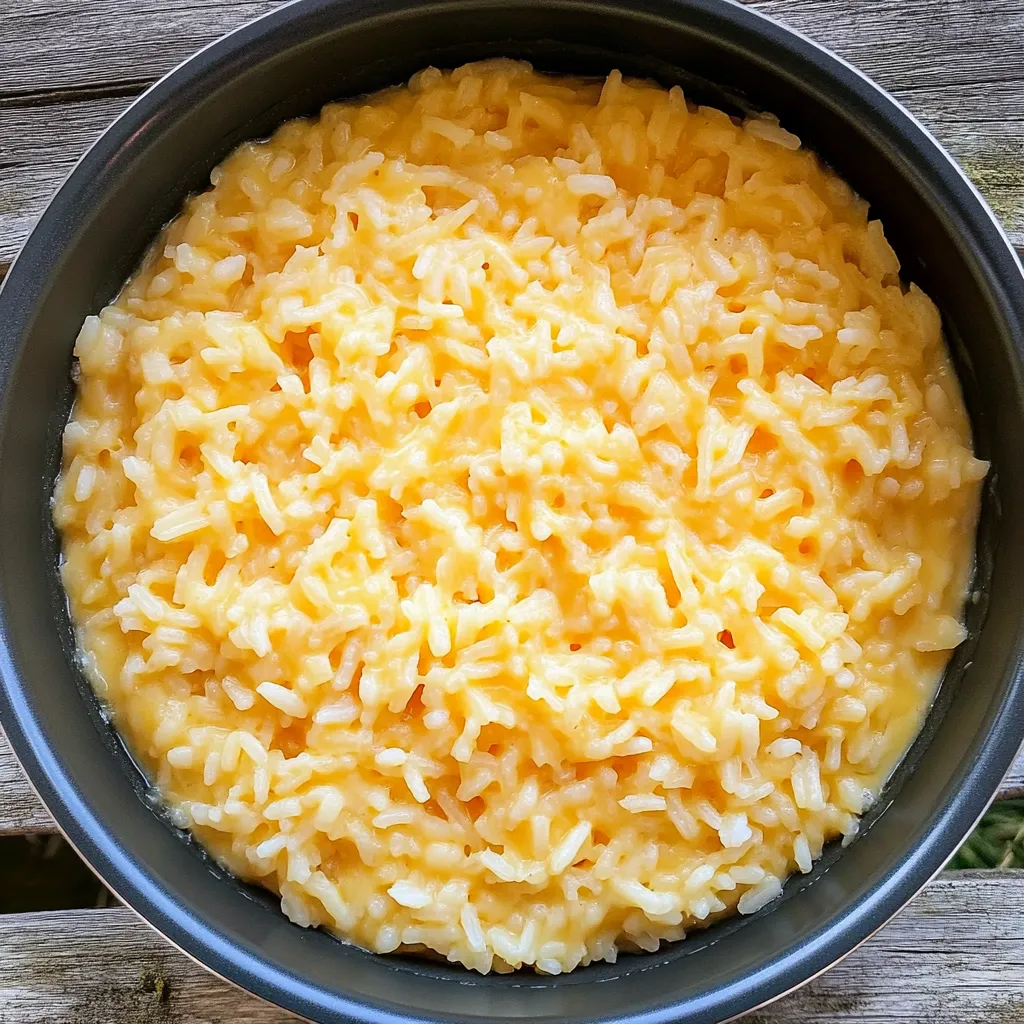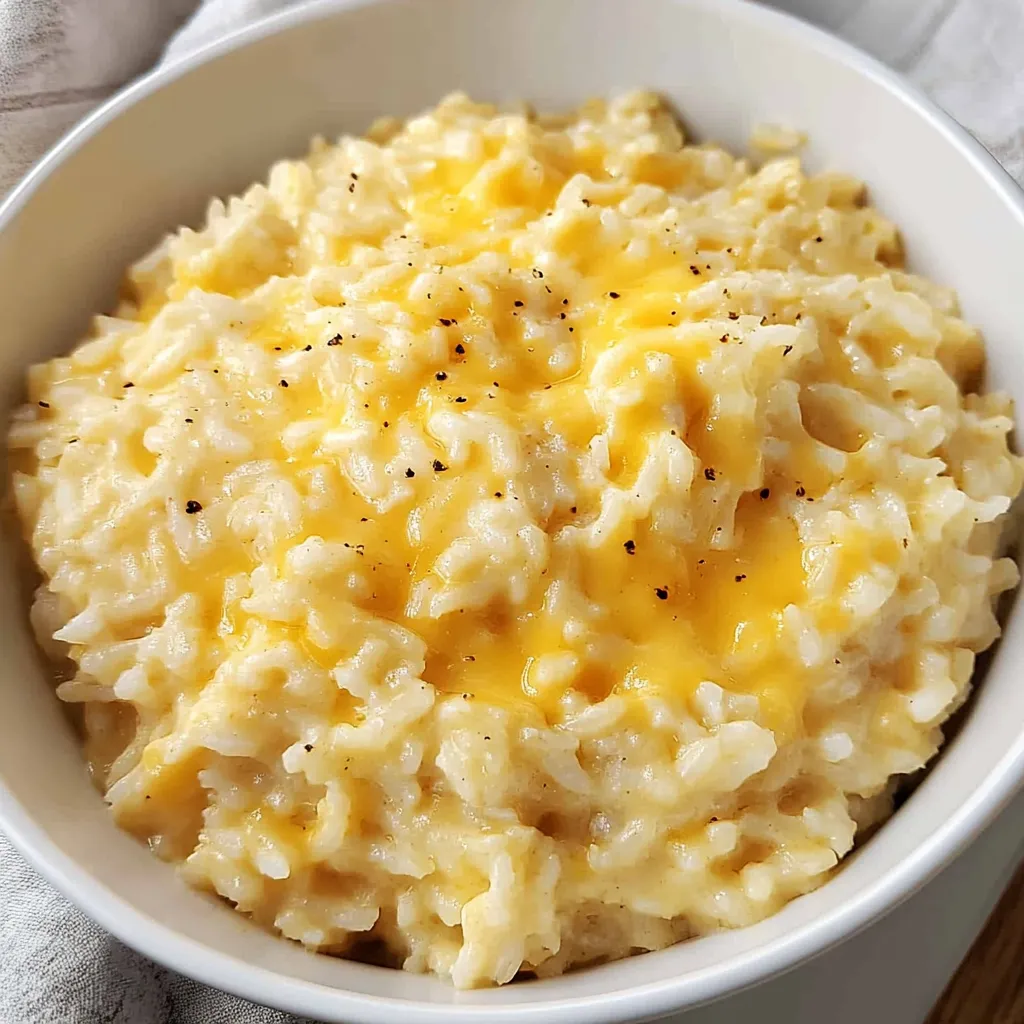 Pin it
Pin it
This one-pot cheesy rice creates the ultimate comfort food that transforms simple pantry ingredients into something incredibly satisfying and creamy. The combination of tender rice cooked in chicken broth with sautéed onions creates a savory base that gets elevated by melted cheese stirred in at the perfect moment. Unlike baked rice dishes that can dry out, this stovetop method keeps every grain perfectly tender while building layers of flavor that make this much more than just rice with cheese melted on top.
I discovered this recipe during one of those nights when I needed something comforting but didn't want to spend hours in the kitchen. What started as a simple side dish quickly became a family favorite that my kids request at least twice a week. There's something magical about how the rice slowly absorbs all those flavors while the cheese creates this incredibly smooth, creamy coating.
Essential Ingredients and Selection Tips
- Long-grain white rice: Choose varieties like jasmine or basmati for the best texture; these grains stay separate and fluffy rather than becoming sticky or mushy when cooked
- Fresh butter: Real butter creates much better flavor than margarine and helps the onions develop that sweet, caramelized taste that forms the flavor foundation
- Yellow or white onion: Sweet onions work beautifully here, but regular yellow onions provide the perfect savory base; avoid red onions as they can overpower the mild cheese flavors
- Quality chicken broth: Low-sodium varieties give you control over the final salt level; avoid broths with artificial flavors that can taste harsh when concentrated
- Whole milk: The fat content is crucial for creating that creamy texture; skim milk will work but won't give you the same rich mouthfeel
- Freshly grated cheese: Block cheese that you grate yourself melts much smoother than pre-shredded varieties, which contain anti-caking agents that can make the sauce grainy
- Sweet paprika: This adds color and a subtle warm flavor without heat; smoked paprika can be substituted for a deeper, more complex taste
The secret to perfect cheesy rice is using freshly grated cheese and adding it off the heat. This prevents the cheese from becoming stringy or separating, creating that silky smooth texture that makes this dish so special.
Detailed Step-by-Step Instructions
- Step 1: Prepare the rice foundation:
- Rinse your rice in a fine-mesh strainer under cold water, stirring gently with your fingers until the water runs mostly clear - this removes excess surface starch that can make rice gummy. In a heavy-bottomed saucepan or Dutch oven, melt the butter over medium heat until it stops foaming and begins to smell nutty and fragrant, about 2-3 minutes.
- Step 2: Build the flavor base:
- Add the diced onion to the melted butter and cook, stirring occasionally, for 5-7 minutes until the onions become translucent and slightly golden around the edges. The onions should be soft and sweet-smelling, not browned or caramelized - this creates the perfect mild flavor foundation that won't compete with the cheese.
- Step 3: Toast the rice:
- Add the rinsed rice to the pot with the sautéed onions and stir continuously for 2-3 minutes until each grain is coated with butter and the rice begins to smell toasty and nutty. This toasting step is crucial for developing deeper flavor and helping the rice maintain its individual grain structure during cooking.
- Step 4: Add liquids and seasonings:
- Pour in the chicken broth and milk, then add the paprika, salt, and pepper, stirring everything together until well combined. Increase the heat to medium-high and bring the mixture to a rolling boil, stirring occasionally to prevent sticking and ensure even heating throughout.
- Step 5: Begin the cooking process:
- Once the liquid reaches a full boil, immediately reduce the heat to the lowest possible setting and cover the pot with a tight-fitting lid. The goal is to maintain just enough heat to keep the liquid barely simmering - you should see only occasional small bubbles around the edges when you lift the lid to check.
- Step 6: Cook undisturbed:
- Allow the rice to cook covered for 18-20 minutes without lifting the lid or stirring, as this releases essential steam and can result in unevenly cooked rice. You'll know it's ready when most of the liquid has been absorbed and the rice feels tender when you test a few grains with a fork.
- Step 7: Check for doneness:
- Gently lift the lid and check that the rice is tender and most liquid has been absorbed - there should be just a small amount of creamy liquid remaining at the bottom. If the rice seems dry, add 2-3 tablespoons of warm water, stir gently, and continue cooking for 2-3 more minutes.
- Step 8: Finish with cheese:
- Remove the pot completely from heat and immediately add the freshly grated cheese, stirring gently but thoroughly until the cheese melts completely and creates a smooth, creamy coating on every grain of rice. The residual heat will melt the cheese perfectly without making it stringy or grainy.
- Step 9: Final seasoning and serving:
- Taste and adjust seasoning with additional salt and pepper as needed, then let the rice rest for 2-3 minutes before serving to allow the flavors to meld and the texture to settle into that perfect creamy consistency.
 Pin it
Pin it
The most important technique here is controlling the heat once you cover the pot - too high and the bottom will burn while the top stays undercooked, too low and the rice won't cook through properly. Finding that sweet spot where the liquid barely bubbles is the key to perfect results every time.
I've always been drawn to recipes that prove comfort food doesn't have to be complicated, and this cheesy rice embodies that philosophy perfectly. My youngest daughter, who can be quite picky about textures, absolutely loves how creamy and mild this dish turns out, while my husband appreciates that it pairs beautifully with everything from grilled chicken to roasted vegetables.
Understanding Rice Varieties and Their Cooking Properties
Different rice varieties behave quite differently when cooked with dairy and broth, making grain selection crucial for success. Long-grain rice varieties like jasmine and basmati have lower starch content and longer, thinner grains that stay separate and fluffy when cooked properly. Medium-grain rice tends to be starchier and can become sticky or gummy when combined with milk, while short-grain rice is best reserved for dishes where you want a creamy, risotto-like texture. Brown rice can be substituted but requires significantly longer cooking time and more liquid, as the bran layer takes longer to soften and absorb flavors.
Mastering Heat Control and Steam Management
Proper heat control is absolutely critical for achieving perfectly cooked rice that's neither mushy nor undercooked. Once you bring the liquid to a boil and reduce the heat, the goal is to maintain just enough heat to keep the liquid barely simmering without creating excessive steam or causing the bottom to scorch. A heavy-bottomed pot distributes heat more evenly and prevents hot spots that can burn the rice. The tight-fitting lid is essential for trapping steam, which actually does most of the cooking work - lifting the lid frequently releases this crucial steam and extends cooking time while potentially creating uneven results.
Cheese Selection and Melting Techniques
The type and preparation of cheese dramatically affects the final texture and flavor of your cheesy rice. Sharp cheddar provides excellent flavor and melting properties, while milder cheeses like Monterey Jack create a smoother, less assertive taste. Gruyere adds sophistication with its nutty undertones, and pepper jack brings gentle heat. Pre-shredded cheese contains cellulose powder to prevent clumping, which can create a grainy texture when melted. Freshly grated cheese from a block melts much more smoothly and incorporates better into the rice, creating that restaurant-quality creamy consistency.
Troubleshooting Common Rice Cooking Issues
Several common problems can occur when making stovetop rice, but most are easily fixable with simple adjustments. If rice appears to be cooking too quickly or sticking to the bottom, reduce heat further and add a splash of warm liquid. Undercooked rice that's absorbed all the liquid needs additional warm broth or water and a few more minutes of covered cooking. Overcooked or mushy rice usually results from too much liquid, too high heat, or excessive stirring during cooking. Rice that turns out too dry typically means either insufficient liquid or too much heat causing rapid evaporation.
Creative Variations and Customization Ideas
This basic cheesy rice serves as an excellent foundation for countless variations that can transform it from a simple side dish into a complete meal. Adding proteins like shredded rotisserie chicken, cooked ground beef, or sliced kielbasa during the last few minutes of cooking creates hearty one-pot dinners. Vegetables like frozen peas, corn, or diced bell peppers can be stirred in halfway through cooking, while heartier vegetables like broccoli or cauliflower should be steamed separately and folded in with the cheese. Seasoning variations like taco seasoning, Italian herbs, or cajun spices can completely change the flavor profile to complement different main dishes.
This cheesy rice has become one of those reliable recipes that I turn to whenever I need something that feels like a warm hug on a plate. The beauty lies in its simplicity - just a few basic ingredients that transform into something much greater than the sum of their parts, proving that the best comfort food often comes from the most straightforward techniques done really well.
Frequently Asked Questions
- → Can I use brown rice instead of white rice?
- Yes, but brown rice takes much longer to cook - about 45 minutes instead of 20. You may need to add extra water during cooking.
- → What type of cheese works best for this recipe?
- Sharp cheddar cheese gives the best flavor and melts well. You can also try mild cheddar or a mix of cheeses like monterey jack.
- → Why do I need to rinse the rice first?
- Rinsing removes extra starch from the rice surface, which prevents it from getting sticky or gummy when cooked.
- → Can I make this recipe dairy-free?
- No, this recipe contains butter, milk, and cheese which are all dairy products. You'd need to substitute all three to make it dairy-free.
- → How long does leftover cheesy rice last?
- Store leftovers in the fridge for 3-4 days in a sealed container. Reheat gently with a splash of milk to restore creaminess.
- → Should I lift the lid while the rice is cooking?
- No, keep the lid on during cooking. Lifting it releases steam and can make the rice dry out or take longer to cook properly.
